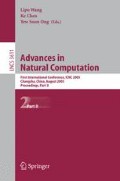Abstract
The accurate control of the work pieces temperature is a nonlinear, large time-delay, and cross-coupling complicated control problem in vacuum annealing furnace. In order to control the temperature of work pieces accurately. The optimization model for accurate work pieces temperature control has been proposed by the data gathered from the scene. The model was set up with Wavelet Neural Networks (WNN). Adaptive Immune Genetic Algorithm (AIGA) optimized the WNN structure and parameters (weights, dilation and translation). Simulation and experiment results show that the model in this paper is better than the model established with NN and optimizing the weights of NN by GA. And, it improves the training rate of Networks and obtains a system with good steady state precision, real timeliness and robustness.
Access this chapter
Tax calculation will be finalised at checkout
Purchases are for personal use only
Preview
Unable to display preview. Download preview PDF.
References
Bloch, G., Sirou, F., Fatrez, P.: Neural intelligent control for a steel plant. IEEE Transactions on neural Networks 8, 910–918 (1997)
Naoharu, Y., Akihiko, H.: Model-based control of strip temperature for the heating furnace in continuous annealing. IEEE Transactions on control systems technology 6, 146–156 (1998)
Cho, Y.C., kwon, W.h., Cassandras, C.G.: Optimal control for steel annealing processes as hybrid systems. In: Proceedings of the 39th IEEE conference on decision and control, Sydney, Australia, pp. 540–545 (2000)
Xiong, W., Zhaohui, Y., Yongmao, X.: An optimal control system on line for the continuous annealing furnace. Computer Simulation, China 16, 61–67 (1999)
Yongzai, L., William, T.J.: Modeling Estimation and Control of the Soaking Pit. Instrument Society of America, New York (1983)
Rengrong, W., Yinwei, S., Wenhai, W., Youxian, S.: A New Method to Optimize the Control of Reheating Furnaces. Control Theory & Applications, China 18, 145–148 (2001)
Xingquan, Z., Shiyong, L.: A Kind of Adaptive Immune Algorithm Used in Optimal Algorithm. Computer Engineering and Applications, China 20, 68–70 (2003)
Zhang, Q., Benveniste, A.: Wavelet Networks. IEEE Transactions on neural Networks 6, 889–898 (1992)
Author information
Authors and Affiliations
Editor information
Editors and Affiliations
Rights and permissions
Copyright information
© 2005 Springer-Verlag Berlin Heidelberg
About this paper
Cite this paper
Li, X., Liu, D. (2005). Modeling and Optimal for Vacuum Annealing Furnace Based on Wavelet Neural Networks with Adaptive Immune Genetic Algorithm. In: Wang, L., Chen, K., Ong, Y.S. (eds) Advances in Natural Computation. ICNC 2005. Lecture Notes in Computer Science, vol 3611. Springer, Berlin, Heidelberg. https://doi.org/10.1007/11539117_129
Download citation
DOI: https://doi.org/10.1007/11539117_129
Publisher Name: Springer, Berlin, Heidelberg
Print ISBN: 978-3-540-28325-6
Online ISBN: 978-3-540-31858-3
eBook Packages: Computer ScienceComputer Science (R0)

